Final Sea Trials
(Updated 9-20-2021)
--Minimus II, Description
--Building Minimus II
--First Sea Trials, July 2020
--Second
Sea Trials, September 2020
--Further
Sailing
Notes
--Back to Adventure Page
We made a few upgrades to Minimus II this summer and in
September trailered her to the Oregon coast for final sea trails. Among
the upgrades were a solar electric system, a centerboard to help her come about
when tacking, a stove upgrade, oars to replace the SUP type paddles and .
We were quite pleased with how they all worked. Below are descriptions of
each.
Solar electric system:
We installed two AcoPower 12V, 30W monocrystalline solar panels on each foredeck.
The panels charge a 12V, 24Ahr LiPo battery by reBel Batteries. We
purchased the LiPo battery mostly to save weight, but have been impressed with
its performance. The charge controller is a PWM type, but will be replaced
by an MPPT type before voyaging for more efficient charging. 12V is used
for the running lights, AIS and compass light. Tablet, phones and InReach
are charged via two 12V to 5V buck converters. Each hull has a converter
located amidship with four 5V outlets. We used buck converters as they're more
efficient than the more common converters that plug into a cigarette lighter
socket.
Although the system is small, and the weather was
partly cloudy, it had more than enough power to keep phones and tablet charged
as well as AIS and LED running lights.
Centerboard:
As noted in our first sea trials report, the boat had difficulty coming
about when tacking. This was due to the hull shape, which was designed for
good tracking while at sea. To solve this, we added a centerboard to
provide more of a pivot point to encourage reliable tacking. It worked
amazingly well. We spent a day offshore, mostly sailing to windward in
light air and didn't miss a single tack. The board takes just a
couple minutes to install.
We don't expect to use the board much while voyaging, but
it's good to know it's available when tacking is necessary.

The centerboard passes through a slot in the center deck board and is
supported laterally
by two dyneema retaining lines on each side. The board is 6'
8" long by 13" wide and 1" thick.
|

The board is lowered into the slot until the two
3/4" diameter holes in the
board
are just above the deck. |
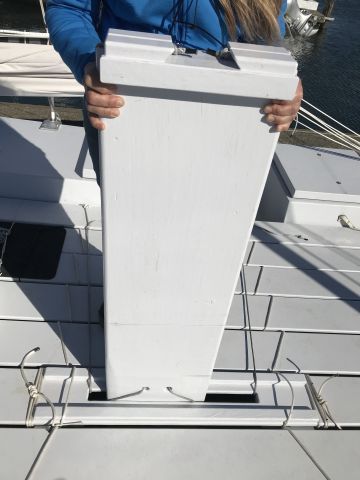
Two 1/4" dyneema lines are permanently attached to the middle and
forward
main beams and pass up through the slot. These lines are fed
through the
two holes in the board and up to chocks at the top of the board.
|

Here, the two lines from the side of the boat Pearl is standing on are
fed through the centerboard holes and up to the chocks. |

All four retaining lines are now in place. |
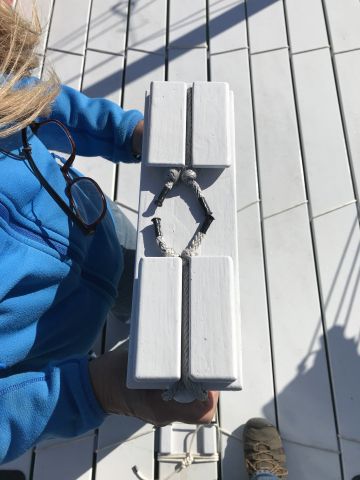
The lines are fed through slots at the top of the board and secured as
shown here and in the next photo. The board is then lowered into
place.
|
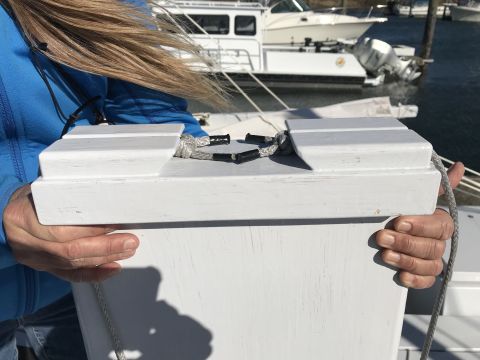
Another view of the chocks for securing the lines.
|
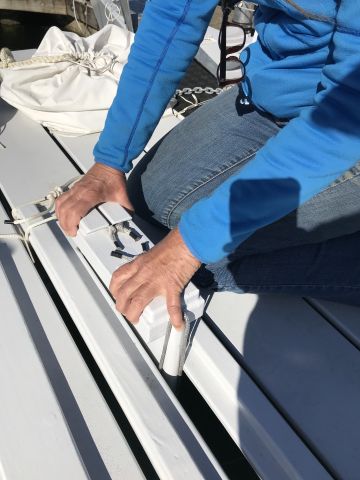
Board is ready to be secured. When sailing, there's quite a bit of
upward
thrust on the board. This is counteracted by a retaining board
shown
in the next few photos.
|

The retaining board is secured by passing a loop of line over its
forward end.
The loop goes around one of the support beams under the deck boards.
|
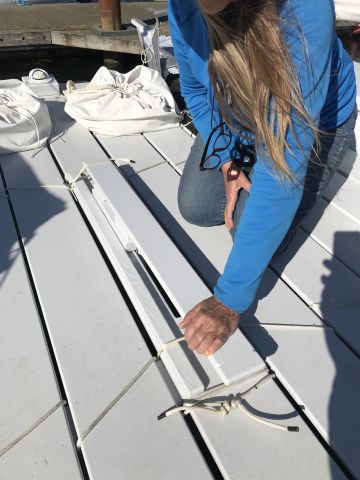
The forward end of the retaining board is pressed down and secured
with a loop of line at its aft end. |

The board is now ready for sailing.
|

Side view of retaining board. |

The four dyneema retaining lines can be seen going from the board up
to where they're secured to the center and forward main beams.
|
|
Oars:
We originally used two SUP type paddles for auxiliary propulsion. Wishing
for a bit more power, we replaced them with two 12' 6" oars and oarlocks. The
oar looms were made from 1-1/2 x 1-1/2" x 10' clear fir boards with blades made
from of 3/4" x 5-1/2" x 4' cedar boards. The oarlocks were experimental, but have
worked better than any we've tried on other boats before. As with the
centerboard description, the photos and captions below will hopefully explain
it.
Here's a link to a video of the oar and oarlock in use:
https://youtu.be/OfUTg-0nKd4
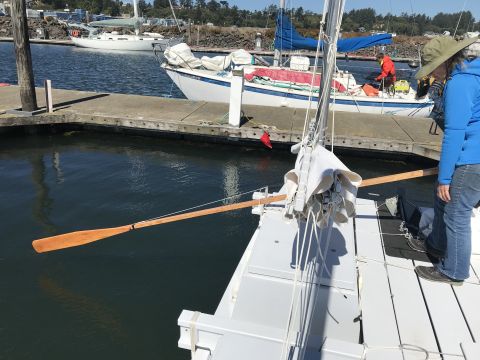
Oar in oarlock. Oarlocks are bolted to port and starboard cabin
tops. |

Base of oarlock is made from a piece of aluminum plate 3/8" thick
by 4" x 6". Plate is through-bolted to cabin top, backed by a
piece of 1/2"
plywood inside the cabin.
The pivot for the oar is a 1/2" x 8" stainless steel bolt secured to the
aluminum
base with nuts and washers. A piece of 1/2" PVC pipe over the bolt
freely
rotates around the bolt. The 1/4" dyneema line keeps the oar in place
on
the pipe and the white retaining line prevents the oar from sliding
downward.
As the oar rotates while rowing, so does the PVC pipe, so
the friction is
between the pipe and the bolt, not between the oar and the pipe.
The action
is very smooth and quiet.
|
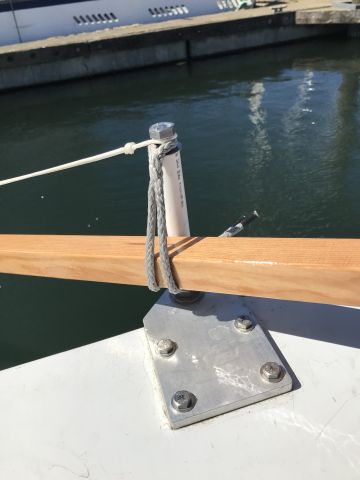
Another view of oarlock. A loop spliced in the dyneema line goes
over the bolt.
|
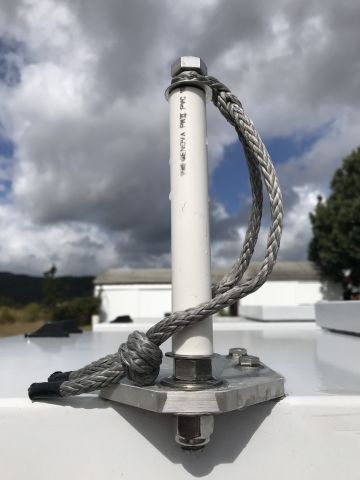
Closeup of oarlock. |
Stove upgrade:
As we mentioned on the Second Sea Trials page, we're using a Gas One
stove than runs on either butane or propane canisters. The piezo electric
igniter makes it very convenient to use. For safety, extra butane
cannisters can be safely stored on deck. We've added a pot support
assembly that gives more stability to the stove and provides adjustable pot
supports.

Gas One stove with pot holder.
|

Pot holder without stove. Base is made from 1/2" x 12" x 12"
plywood.
Four bolts in center secure stove to pot holder.
Pot holders pivot around three bolts near edge of board.
In use, pot is placed on stove, then the three wing nuts are loosened,
pot holders
are pivoted against pot and tightened.
For use on a multihull while sailing or on a monohull at anchor, it's a
very secure setup.
|

Underside of pot holder showing carriage bolt heads. Rubber
pads at corners make the pot holder and stove assembly very
resistant to sliding on countertop.
|

Detail of pivoting pot holder. Bolt on left is a fully threaded
5/16" x 6" carriage bolt.
Pivot arm is made from 1/8" x 1" x 4" aluminum bar stock. Bolt on
right is 1/4" x 3-1/2" hex head
machine bolt with head cut off.
|

Stove mounted on pot holder and secured with four bolts.
|

Stove and pot holder assembly ready for use. |
Parachute sea anchor:
One upgrade we didn't have an opportunity to test is a parachute sea anchor we
made. It's purpose is not so much for storm conditions as for holding
position. That can be handy when approaching a harbor at night and waiting
for dawn to enter. It's 7' in diameter and made from 4oz. nylon fabric.

Pearl struggles to hold onto parachute sea anchor in
wind.























